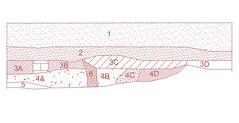 The Port Tobacco Archaeological Project's new traveling exhibit premiered this weekend in the Flowers Building at the Charles County Fair. The exhibit poses questions about the effects of human occupation on the Port Tobacco Valley and shows how archaeological research has produced data that allow us to document and date significant environmental events.
The Port Tobacco Archaeological Project's new traveling exhibit premiered this weekend in the Flowers Building at the Charles County Fair. The exhibit poses questions about the effects of human occupation on the Port Tobacco Valley and shows how archaeological research has produced data that allow us to document and date significant environmental events.The Charles County Garden Club invited us to present the exhibit in their hall at the fair, and I am very grateful for the invitation and their help in registering the exhibit at the Fair office. Bonnie Persinger did the initial design work and then partnered with Kathryn Burns of the Bridge Gallery in Shepherdstown, West Virginia, to complete the design. Ms Burns did a marvelous job of fabricating the final product.
Of course, the content of the exhibit was made possible by the hard work and contributions of members of the Charles County Archaeological Society and Archeological Society of Maryland, Cathy Hardy and Donna Dudley of Charles County Government, and donations from Ed and Lexy Edelen, Sheila Smith, the Southern Maryland Heritage Areas Consortium (Roslyn Racanello, Executive Director), and Preservation Maryland. We hope this is the first in a series of increasingly content rich, ambitious exhibits that engage the public in historical and environmental issues that resonate today.
Jim
PS. Yes, that is a red ribbon on the table to the right. The purpose wasn't to compete for awards, but what the hell...take the glory where you can.


















